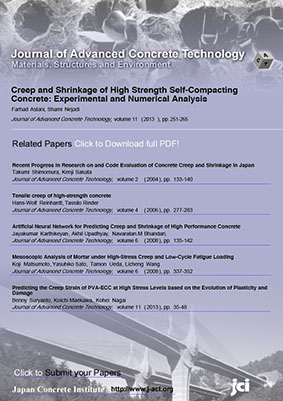
- |<
- <
- 1
- >
- >|
-
Nobuhiro Chijiwa, Shuntaro Hayasaka, Koichi Maekawa2018 Volume 16 Issue 1 Pages 1-17
Published: January 16, 2018
Released on J-STAGE: January 17, 2018
JOURNAL FREE ACCESSMiddle-scale box-sectional hollow PC ducts, which consist of heterogeneous concrete with different mix proportions, were exposed to natural environments for about three years, and the long-term curvature and axial mean deformation, which have much to do with deflection of long span bridge viaducts, was gaged for verification of coupled ther-mo-hygral and multi-scale models. The associated internal moisture and the local climate inside micro-pores were measured and the effect of precipitation was quantified over yearly four seasons. The moisture migration linked with concrete multi-scale mechanics was analyzed and the simulation results are compared with the field exposure tests. The reliability of the thermo-hygral analysis, which has been used for estimating the long-term serviceability of bridges, was made firmer.
View full abstractDownload PDF (5633K) -
Yuichiro Kawabata, Kazuo Yamada, Go Igarashi, Yasutaka Sagawa2018 Volume 16 Issue 1 Pages 61-74
Published: January 27, 2018
Released on J-STAGE: January 27, 2018
JOURNAL FREE ACCESSAlkali release from aggregates is considered to cause expansion due to the alkali-silica reaction (ASR), owing to the increase in the hydroxide ion concentration (namely pH) of the pore solution. However, a direct validation of this assertion has not yet been made. In this research, the effects of the type of soak solution, which might better mimic the composition of the pore solution, on the behavior of alkali release from aggregates are investigated through immersion tests of aggregates. More importantly, accompanying ions dissolved from the aggregates are also measured in order to determine the mechanism for the increase in hydroxide ion concentration of the pore solution. The test results show that this increase can barely be observed, despite a considerable amount of alkalis being released. The results critically question the conventional view that alkali released from an aggregate serves to accelerate the ASR.
View full abstractDownload PDF (630K)
-
Rungrawee Wattanapornprom, Tetsuya Ishida2018 Volume 16 Issue 1 Pages 18-35
Published: January 18, 2018
Released on J-STAGE: January 19, 2018
JOURNAL FREE ACCESSThe deterioration of concrete structures in airborne chloride environments is a common problem, as attested by the large number of concrete structures in coastal areas that are in need of repair due to corrosion of steel reinforcement. Thus, to prolong the service of concrete infrastructure in marine environments, deterioration from airborne chloride should be carefully considered. However, the amount of airborne chloride is influenced by numerous factors including wind direction, wind speed, wave height, obstacles, and distance from the seashore, and the concentration of airborne chloride varies by time and location. Besides actual exposure conditions, chloride ingress depends also on the environmental condition. In order to design the concrete structures, one must consider the amount of airborne chloride, concrete qualities, and the environmental conditions. Consequently, this research aims to develop a comprehensive system that can predict chloride ingress in concrete structures by considering airborne chloride intensity at the specific locations and times, based on determination of the amount of airborne chloride generated by breaking waves and transported by wind flow. The proposed methodology can determine the chloride penetration into concrete structures in various marine environments. The numerical framework has been verified through on-site measurements to confirm its validity.
View full abstractDownload PDF (5952K) -
Koki Makita, Yoshifumi Uda, Hiroshi Yoshikado, Koji Mori, Yuichi Sato, ...2018 Volume 16 Issue 1 Pages 36-45
Published: January 25, 2018
Released on J-STAGE: January 27, 2018
JOURNAL FREE ACCESSDrop-weight tests and static loading tests of RC frames made of polypropylene fiber-reinforced concrete are conducted to observe shock resistance performance and residual ductility. Experimental variables are fiber content and mass of the drop weight. In the impact test, the maximum drifts of the specimens are proportional to the mass of the drop weight although several collisions occur due to rebounding and the maximum acceleration is not always increased as the mass increases. In a static loading test, the initial stiffness is improved and crack lengths in the hinge areas of the columns are reduced by mixing the polypropylene fibers.
View full abstractDownload PDF (2982K) -
Yuya Takahashi, Yasushi Tanaka, Koichi Maekawa2018 Volume 16 Issue 1 Pages 46-60
Published: January 23, 2018
Released on J-STAGE: January 23, 2018
JOURNAL FREE ACCESSTo estimate the remaining life of existing RC bridge decks damaged by alkali silica reaction (ASR), multi-scale numeri-cal analysis with chemo-hygral model is integrated with visual inspection data at site. First, the applicability of the poro-mechanical models for ASR expansion in the multi-scale frame are examined with the experiments of the real scale RC slabs and the model is validated to bring about fair prediction of the 3D anisotropic expansion and the fatigue life of the slabs. Second, visually inspected cracks on bottom surfaces of RC decks are converted to space-averaged strains, and the magnitude of ASR is estimated from the vertical deformation, based on which the internal pre-stress and the damage fields are re-produced by numerical predictor-corrector cycles, and the remaining life of ASR damaged RC bridge decks is fairly estimated. By conducting sensitivity analyses in terms of ASR-gel volumes and cracks, allowable error range of site inspection data is clarified to meet the requirement of asset management.
View full abstractDownload PDF (6823K)
- |<
- <
- 1
- >
- >|